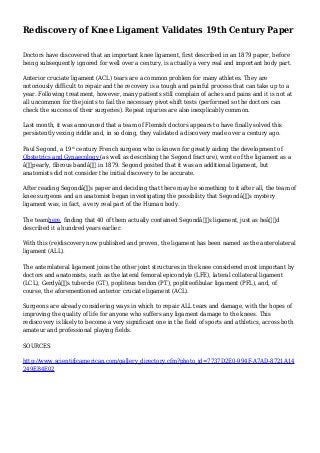Rediscovery of Knee Ligament Validates 19th Century Paper
•
0 recomendaciones•85 vistas
Doctors have discovered that an important knee ligament, first described in an 1879 paper, before be...
Denunciar
Compartir
Denunciar
Compartir
Descargar para leer sin conexión

Recomendados
Recomendados
More than Just Lines on a Map: Best Practices for U.S Bike Routes
This session highlights best practices and lessons learned for U.S. Bike Route System designation, as well as how and why these routes should be integrated into bicycle planning at the local and regional level.
Presenters:
Presenter: Kevin Luecke Toole Design Group
Co-Presenter: Virginia Sullivan Adventure Cycling AssociationMore than Just Lines on a Map: Best Practices for U.S Bike Routes

More than Just Lines on a Map: Best Practices for U.S Bike RoutesProject for Public Spaces & National Center for Biking and Walking
Más contenido relacionado
Destacado
More than Just Lines on a Map: Best Practices for U.S Bike Routes
This session highlights best practices and lessons learned for U.S. Bike Route System designation, as well as how and why these routes should be integrated into bicycle planning at the local and regional level.
Presenters:
Presenter: Kevin Luecke Toole Design Group
Co-Presenter: Virginia Sullivan Adventure Cycling AssociationMore than Just Lines on a Map: Best Practices for U.S Bike Routes

More than Just Lines on a Map: Best Practices for U.S Bike RoutesProject for Public Spaces & National Center for Biking and Walking
Destacado (20)
Content Methodology: A Best Practices Report (Webinar)

Content Methodology: A Best Practices Report (Webinar)
How to Prepare For a Successful Job Search for 2024

How to Prepare For a Successful Job Search for 2024
Social Media Marketing Trends 2024 // The Global Indie Insights

Social Media Marketing Trends 2024 // The Global Indie Insights
Trends In Paid Search: Navigating The Digital Landscape In 2024

Trends In Paid Search: Navigating The Digital Landscape In 2024
5 Public speaking tips from TED - Visualized summary

5 Public speaking tips from TED - Visualized summary
Google's Just Not That Into You: Understanding Core Updates & Search Intent

Google's Just Not That Into You: Understanding Core Updates & Search Intent
The six step guide to practical project management

The six step guide to practical project management
Beginners Guide to TikTok for Search - Rachel Pearson - We are Tilt __ Bright...

Beginners Guide to TikTok for Search - Rachel Pearson - We are Tilt __ Bright...
Unlocking the Power of ChatGPT and AI in Testing - A Real-World Look, present...

Unlocking the Power of ChatGPT and AI in Testing - A Real-World Look, present...
More than Just Lines on a Map: Best Practices for U.S Bike Routes

More than Just Lines on a Map: Best Practices for U.S Bike Routes
Ride the Storm: Navigating Through Unstable Periods / Katerina Rudko (Belka G...

Ride the Storm: Navigating Through Unstable Periods / Katerina Rudko (Belka G...
Good Stuff Happens in 1:1 Meetings: Why you need them and how to do them well

Good Stuff Happens in 1:1 Meetings: Why you need them and how to do them well
Rediscovery of Knee Ligament Validates 19th Century Paper
- 1. Rediscovery of Knee Ligament Validates 19th Century Paper Doctors have discovered that an important knee ligament, first described in an 1879 paper, before being subsequently ignored for well over a century, is actually a very real and important body part. Anterior cruciate ligament (ACL) tears are a common problem for many athletes. They are notoriously difficult to repair and the recovery is a tough and painful process that can take up to a year. Following treatment, however, many patients still complain of aches and pains and it is not at all uncommon for the joints to fail the necessary pivot-shift tests (performed so the doctors can check the success of their surgeries). Repeat injuries are also inexplicably common. Last month, it was announced that a team of Flemish doctors appears to have finally solved this persistently vexing riddle and, in so doing, they validated a discovery made over a century ago. Paul Segond, a 19th century French surgeon who is known for greatly aiding the development of Obstetrics and Gynaecology (as well as describing the Segond fracture), wrote of the ligament as a “pearly, fibrous band†in 1879. Segond posited that it was an additional ligament, but anatomists did not consider the initial discovery to be accurate. After reading Segond’s paper and deciding that there may be something to it after all, the team of knee surgeons and an anatomist began investigating the possibility that Segond’s mystery ligament was, in fact, a very real part of the Human body. The teamhere, finding that 40 of them actually contained Segond’s ligament, just as he’d described it a hundred years earlier. With this (re)discovery now published and proven, the ligament has been named as the anterolateral ligament (ALL). The anterolateral ligament joins the other joint structures in the knee considered most important by doctors and anatomists, such as the lateral femoral epicondyle (LFE), lateral collateral ligament (LCL), Gerdy’s tubercle (GT), popliteus tendon (PT), popliteofibular ligament (PFL), and, of course, the aforementioned anterior cruciate ligament (ACL). Surgeons are already considering ways in which to repair ALL tears and damage, with the hopes of improving the quality of life for anyone who suffers any ligament damage to the knees. This rediscovery is likely to become a very significant one in the field of sports and athletics, across both amateur and professional playing fields. SOURCES http://www.scientificamerican.com/gallery_directory.cfm?photo_id=7737D2E0-994F-A7AD-8721A14 249EB4E02